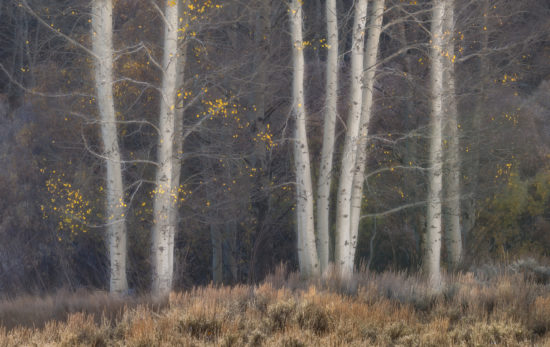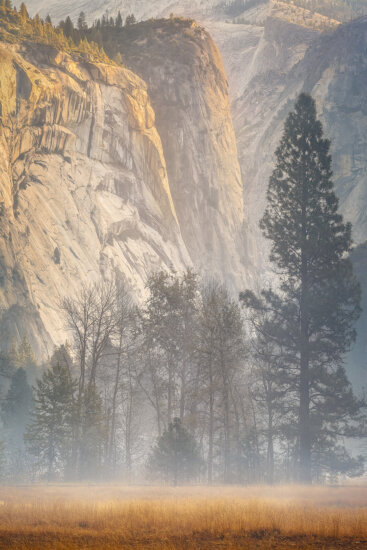6 Steps to Making More Creative Landscape Photographs
Okay, you’ve learned the basics of how your camera works, you understand the relationship between f-stop, shutter speed and ISO, and you’ve finally made peace with your tripod. So, now what? How do you make more creative landscape photographs?

“Portal” — When I came upon this scene, I quickly decided I wanted just the reflections of the monument in my frame, rather than include the sky and the background. This is a focus stack of six images, but I didn’t let the technical difficulty of creating this image get in the way of my vision.
1. Quiet the technical voice in your head.
You’ve done the work, and you know your camera. You should be able to operate it with your eyes closed. If not, go practice in a darkened space until you are familiar with every single button on your camera. Your camera is supposed to be an extension of your hands. Your workflow should be solid by now, so let your creative voice take the lead. Feel and experience what nature is showing you before you even set up your camera. Be curious. Explore your surroundings. Have faith in what you know technically, but don’t let the technical voice “drive the bus”.

“Winter Arrives” — When I made this photograph, conditions were severe. It was very cold and the snow was blowing sideways. I had my camera covered with a thick, opaque rain sleeve, which wasn’t working very well. The camera was protected, yes, but I couldn’t see what I was doing. In this case, knowing my camera backwards and forwards served me well.
2. Love the process.
Don’t dwell too much on the outcome of your work. Yes, visualize what you are trying to achieve, but don’t forget to stay in the moment and enjoy the process. Let the work itself be the reward. If you don’t love what you are doing, it will reflect in your images. So, if you are not okay with getting up at ridiculous hours, enduring some physical discomfort or chasing storms, your unhappiness will reflect in the emotional quality of your images. So, have fun! Adjust your experience to your comfort level until you can focus completely on your work and not on your discomfort.

“Bridalveil” — I hadn’t set out to make this image the day I went for a hike. It was mid-day, not an ideal time to be making award-winning landscape pictures. But I was happy and relaxed, so was able to really see the essence of this waterfall and that came through in this image.
3. Listen to your inner voice.
Your life experiences, the sum of your existence so far as you’ve walked this planet, will come through in the expression of your photography. You can’t help it. It just will, so tap into that and pay attention to how you are reacting to a scene, then try to communicate it visually. What is moving you emotionally about the scene? Answer that question and focus. You see your surroundings uniquely from everyone around you because you are you.

“Eastern Sierra Enchantment” — I am drawn to trees, in particular, probably because I grew up near a forest and spent my childhood exploring every part of the woods. What specifically from your life experiences inspires you?
4. Live creatively.
Write poetry. Play an instrument. Work in a garden. Make stuff with your hands. Engage with the creative world outside of your photography. You probably already do creative things in your life that don’t even think about! Feed those activities and let them feed your creative soul. Visit art museums. Study the masters and spend time with those works of the great painters, photographers, architects, and sculptures/sculptresses that move you emotionally.

“Royal Arches Dawn” —The day previous to making this composition, I visited the Yosemite Gallery, which had an exhibit of 18th and 19th century landscape paintings by Thomas Ayers, Albert Bierstadt and Thomas Moran. This collection of work clearly influenced the making of this image.
5. Cross train.
Try making photographs in a different genre, like portraits, street photography, or wildlife. Your brain must work differently in each of these disciplines and you will become a better photographer.

“Angel’s Wings” — I don’t consider myself a “wildlife photographer”, but when the given the opportunity to go to Japan and photograph the Whooper Swans in Hokkaido, I jumped at the chance. Wildlife photography requires a different skill set than landscape photography and it forced me to think differently about my camera work.
6. Take bad pictures and embrace failure.
Ok, I realize this sounds like bad advice, but trust me! It is not! Don’t get addicted to your successes. Success only happen through failure. Every artist creates bad work. It is an intrinsic part of the process to make creative landscape photographs, so if you place unreasonable expectations on yourself, you are very likely to be unhappy and give up. Don’t give up just because you aren’t the genius you expect yourself to be!
Feel free to share your own experiences in comments below.




Excellent points, Charlotte. And beautiful images to illustrate.
“You should be able to operate it with your eyes closed. If not, go practice in a darkened space until you are familiar with every single button on your camera.”
One area where digital cameras are hopelessly outclassed by film cameras–and digital manufacturers could care less. I don’t know how many times I’ve missed thing because I had to stop and read the LCD screen to get the camera to the settings I wanted instead of being able to keep the viewfinder to the eye and adjust the camera by touch.
Wendy, it can be even worse than that. I sometimes mess up an image because I actually forget to re-set a parameter which had previously been changed. The FTb I used forty years ago had aperture, speed and focus. That was it. The manual of my EOS-R has 631 pages. And whilst the 5D, 60D, 70D, etc had almost the same button layout, Canon’s mirrorless models have half the buttons missing. Whoever had that idea should fall on his sword.
My conclusion is that whilst one can’t argue against Charlotte’s advice, if you are an amateur who does not use their camera every day then it is not necessarily so easy to follow.
Those are some great tips! If I may add one as well, it “Don’t be afraid to try something new”. Taking 10 pictures of the same thing gets boring. Try an extreme angle, or take a few steps back to get more of the surrounding environment in the shot.
Only if you take those ten pictures the same way. Making yourself take ten DIFFERENT pictures of the same thing is a great way to develop your sense of composition.
Great examples Charlotte :)